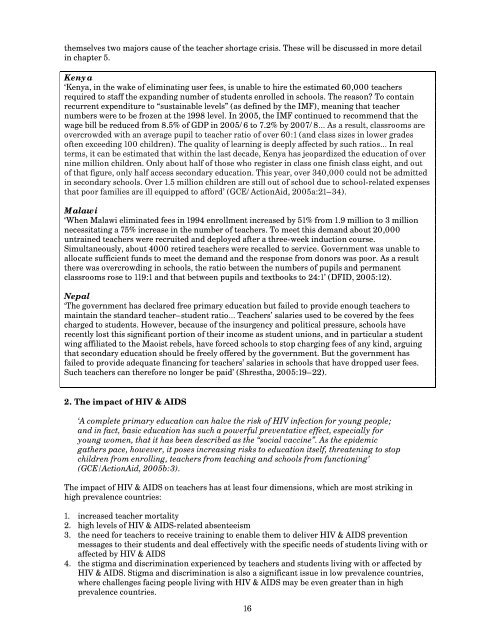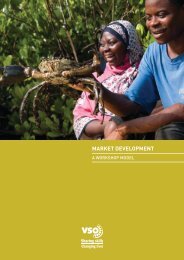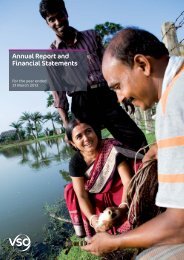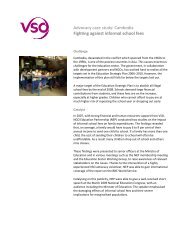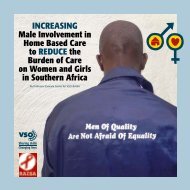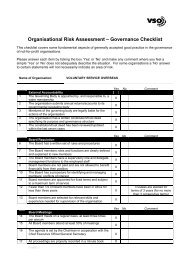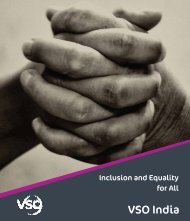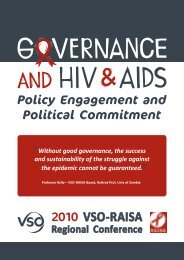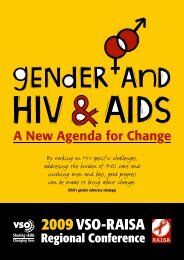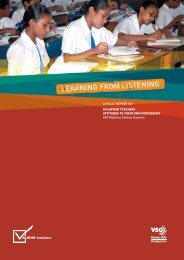Teachers for All â GCE policy briefing (566KB) - VSO
Teachers for All â GCE policy briefing (566KB) - VSO
Teachers for All â GCE policy briefing (566KB) - VSO
You also want an ePaper? Increase the reach of your titles
YUMPU automatically turns print PDFs into web optimized ePapers that Google loves.
themselves two majors cause of the teacher shortage crisis. These will be discussed in more detailin chapter 5.Kenya‘Kenya, in the wake of eliminating user fees, is unable to hire the estimated 60,000 teachersrequired to staff the expanding number of students enrolled in schools. The reason? To containrecurrent expenditure to “sustainable levels” (as defined by the IMF), meaning that teachernumbers were to be frozen at the 1998 level. In 2005, the IMF continued to recommend that thewage bill be reduced from 8.5% of GDP in 2005/6 to 7.2% by 2007/8… As a result, classrooms areovercrowded with an average pupil to teacher ratio of over 60:1 (and class sizes in lower gradesoften exceeding 100 children). The quality of learning is deeply affected by such ratios… In realterms, it can be estimated that within the last decade, Kenya has jeopardized the education of overnine million children. Only about half of those who register in class one finish class eight, and outof that figure, only half access secondary education. This year, over 340,000 could not be admittedin secondary schools. Over 1.5 million children are still out of school due to school-related expensesthat poor families are ill equipped to af<strong>for</strong>d’ (<strong>GCE</strong>/ActionAid, 2005a:21–34).Malawi‘When Malawi eliminated fees in 1994 enrollment increased by 51% from 1.9 million to 3 millionnecessitating a 75% increase in the number of teachers. To meet this demand about 20,000untrained teachers were recruited and deployed after a three-week induction course.Simultaneously, about 4000 retired teachers were recalled to service. Government was unable toallocate sufficient funds to meet the demand and the response from donors was poor. As a resultthere was overcrowding in schools, the ratio between the numbers of pupils and permanentclassrooms rose to 119:1 and that between pupils and textbooks to 24:1’ (DFID, 2005:12).Nepal‘The government has declared free primary education but failed to provide enough teachers tomaintain the standard teacher–student ratio… <strong>Teachers</strong>’ salaries used to be covered by the feescharged to students. However, because of the insurgency and political pressure, schools haverecently lost this significant portion of their income as student unions, and in particular a studentwing affiliated to the Maoist rebels, have <strong>for</strong>ced schools to stop charging fees of any kind, arguingthat secondary education should be freely offered by the government. But the government hasfailed to provide adequate financing <strong>for</strong> teachers’ salaries in schools that have dropped user fees.Such teachers can there<strong>for</strong>e no longer be paid’ (Shrestha, 2005:19–22).2. The impact of HIV & AIDS‘A complete primary education can halve the risk of HIV infection <strong>for</strong> young people;and in fact, basic education has such a powerful preventative effect, especially <strong>for</strong>young women, that it has been described as the “social vaccine”. As the epidemicgathers pace, however, it poses increasing risks to education itself, threatening to stopchildren from enrolling, teachers from teaching and schools from functioning’(<strong>GCE</strong>/ActionAid, 2005b:3).The impact of HIV & AIDS on teachers has at least four dimensions, which are most striking inhigh prevalence countries:1. increased teacher mortality2. high levels of HIV & AIDS-related absenteeism3. the need <strong>for</strong> teachers to receive training to enable them to deliver HIV & AIDS preventionmessages to their students and deal effectively with the specific needs of students living with oraffected by HIV & AIDS4. the stigma and discrimination experienced by teachers and students living with or affected byHIV & AIDS. Stigma and discrimination is also a significant issue in low prevalence countries,where challenges facing people living with HIV & AIDS may be even greater than in highprevalence countries.16


